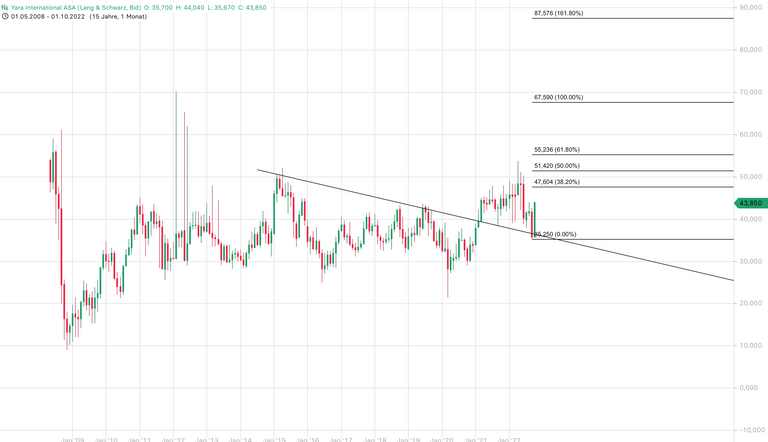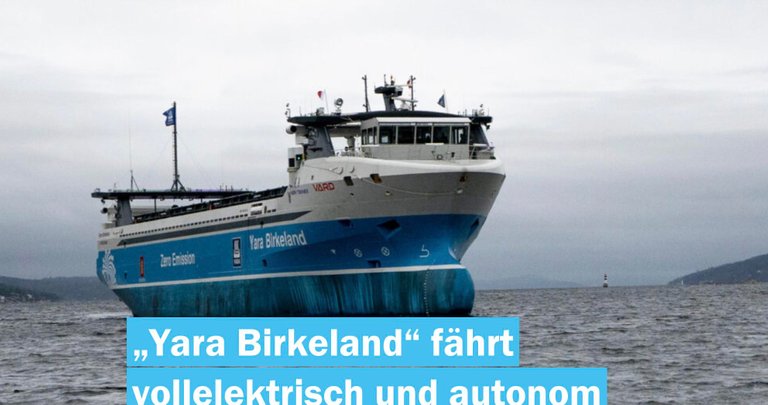Yara Is Going The Right Way, At Least In Transportation

The crisis as a motor for innovation
The Norwegians are taking big steps towards the future and presenting the revolution in transportation. Personally, I know the Yara company only in connection with heavy oil and very toxic chemicals. Several factory inspections have opened my eyes and shown me what is really inside fertilizer for agriculture.
Fertilizer is an export hit worldwide and since the war in Ukraine even more so, because Russia is one of the largest producers of fertilizer. No matter how one may think about mineral fertilizer, the world needs it for intensive agriculture and as long as we do not completely switch to organic farming, this dependence will continue.
However, Yara also has an eye on the future and this is done in a separate business area. Fertilizer transport has been taken to a new level, and the crisis is acting as an accelerant here. Diesel is expensive and trucks clog the roads, now the future is really being addressed, at least in this area.
A fully autonomous ship will make 40000 truck trips superfluous in the future and this is just the beginning. We can only hope that this technology will also be used on a large scale on the world's oceans. High transport costs and lack of personnel would then be over, because expensive captains, helmsmen etc. would then be omitted.
Norway produces its electricity predominantly regeneratively and therefore the transport is nearly CO2 neutral.
The construction of the "Yara Birkeland" in a shipyard of VARD in Alesund cost around 250 million Norwegian kroner, the equivalent of around 24.7 million euros. The ship is powered by green electricity generated from hydropower. At the heart of the propulsion system is a battery system from Swiss manufacturer Leclanché with a storage capacity of 6.7 megawatt hours (MWh) - roughly equivalent to the energy content of 130 Tesla batteries.
The future is here, and if our governments are serious about their promises to the energy transition, projects like this are a very good example for their own projects in the country. Rail and water were the best transportation option back in the early days, cheap gasoline and diesel have changed that though, why not go back to the beginning now.
The wild chart of the Yara share is difficult to interpret, but the last movement is quite positive. A Bounce is nevertheless always what fine and as soon as we overcome the last highs with 53.73€, there are also prices up to the 161% Fib with approximately 87.50€ possible. Fertilizer is ecologically still bad for our soils, but intensive agriculture is hardly otherwise presentable at the moment, but at least the research in transportation has now really paid off in the crisis.
Translated with www.DeepL.com/Translator (free version)

Die Krise als Motor für Innovation
Die Norweger gehen mit großen Schritten Richtung Zukunft und präsentieren die Revolution im Transportwesen. Persönlich kenne ich das Yara Unternehmen nur in Verbindung mit Schweröl und sehr giftigen Chemikalien. Mehrere Werksrevisionen haben mir die Augen geöffnet und gezeigt was im Dünger für die Landwirtschaft wirklich drinnen steckt.
Dünger ist Weltweit ein Exportschlager und seit dem Krieg in der Ukraine noch viel mehr, denn Russland gehört zu den größten Herstellern von Düngermitteln. Egal wie man über Mineraldünger denken mag, die Welt benötigt diesen für eine intensive Landwirtschaft und solange wir nicht komplett auf Biolandbau umstellen, solange wird diese Abhängigkeit auch weiterhin bestehen.
Die Yara hat aber auch die Zukunft im Blick und dies in einem separaten Geschäftsbereich. Der Transport von Dünger ist auf ein neues Level gehoben worden, die Krise wirkt hier wie ein Brandbeschleuniger. Diesel ist teuer und LKWs verstopfen die Straßen, jetzt wird zumindest in diesem Bereich die Zukunft wirklich angegangen.
Ein voll autonomes Schiff wird zukünftig 40000 LKW Fahrten überflüssig machen und dies ist nur der Anfang. Bleibt zu hoffen, dass sich diese Technik auch im großen Stiel auf den Weltmeeren durchsetzt. Hohe Transportkosten und Personalmangel wären dann vorbei, denn teure Kapitäne, Steuermänner usw fallen dann weg.
Norwegen produziert seinen Strom überwiegend regenerativ und deshalb ist der Transport nahezu CO2 neutral.
Rund 250 Millionen norwegische Kronen, umgerechnet rund 24,7 Millionen Euro kostet der Bau der „Yara Birkeland“ in einer Werft von VARD in Alesund. Angetrieben wird das Schiff mit Grünstrom, der mit Wasserkraft erzeugt wurde. Herzstück des Antriebs ist ein Batteriesystem des Schweizer Herstellers Leclanché mit einer Speicherkapazität von 6,7 Megawattstunden (MWh) – das entspricht in etwa dem Energiegehalt von 130 Tesla-Batterien.
Die Zukunft ist da und wenn unsere Regierungen ihre Versprechen gegenüber der Energiewende ernst meinen, dann sind solche Projekte ein sehr gutes Bespiel für eigenen Projekte im Land. Die Schiene und das Wasser waren schon in den Anfängen die beste Transportmöglichkeit, billiges Benzin und Diesel haben dies allerdings verändert, warum nicht jetzt wieder zurück zu den Anfängen.
Der wilde Chart der Yara Aktie ist schwer zu deuten, jedoch ist die letzte Bewegung ziemlich positiv zu werten. Ein Bounce ist doch immer was feines und sobald wir die letzten Hochs bei 53.73€ überwinden, da sind auch Preise bis zum 161% Fib bei rund 87.50€ möglich. Dünger ist ökologisch weiterhin schlecht für unsere Böden, jedoch ist eine intensive Landwirtschaft kaum anders darstellbar momentan, zumindest aber hat sich die Forschung im Transportwesen jetzt in der Krise wirklich ausgezahlt.
Quelle:
https://edison.media/umwelt/yara-birkeland-faehrt-vollelektrisch-und-autonom/25222875/
Posted Using LeoFinance Beta